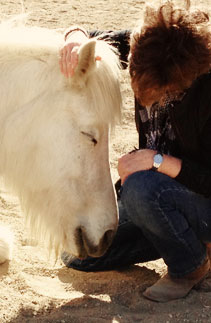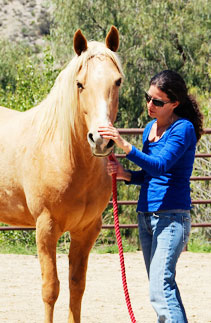Generally, a session lasts 45-50 minutes unless the client requests more time. Clients can schedule a regular therapy session, an hour session, double session etc. much like “in office” therapy; or in the case of businesses, spiritual retreats or self-care groups, clients may want to schedule a half day or day long experience.
After the client checks in with our team (porch time/talk therapy time) to review current thoughts, feelings, last week’s session, etc., we generally start to engage with the equines in the arena. In the arena or donkey area, clients may spend time with the equines observing the herd dynamics (which often “mirror” the clients’ current situation) or clients may spend time in a more structured activity with the horses or donkeys.
An example of a structured activity might include “building a course” that metaphorically represents an aspect of the client’s life. The client will be asked to associate to the metaphors as well as noting the equines’ behaviors in the arena. The client may walk the equine through the course, or might choose to observe how the equines interact with their life course or current therapeutic issue.
Another example of a session may include grooming the horse and participating in talk therapy as the client grooms the horse. The session options for this animal (equine) assisted psychotherapy are limitless and primarily depends on the creativity of the clinicians and clients!
Whatever activity we choose, the client will end up experiencing some interactive feedback from the equines that is pertinent to the client’s current feeling state, life challenges or situation. The equine clinician always joins the mental health clinician in the arena (or barn) with the client. The mental health clinician may interact with the client throughout the session or ask processing questions at a later point in the session. Regardless of how the session is structured, the mental health team uses this time to facilitate emotional growth and healing. Clinical skills and style will determine the structure of the therapy session.
For businesses looking to improve their team dynamics, the equine assisted activities provide a great deal of fun and information regarding the company’s staff dynamics, strengths and challenges. The EAP team makes observations in the arena which they later process with the group, usually after the activity is completed. A clinician’s group therapy skills will make a direct impact on the quality of these group sessions. A tremendous amount is learned through both the client participation and the session processing time. Equine Assisted company retreats are life-giving, engaging, relaxing fun and fascinating. What a great way for a company to play and illuminate their dynamics all at the same time! We believe these types of company experiences enhance staff cohesiveness and productivity.
Read a first-hand account by Elisha Goldstein, Ph.D. of what happened during a workshop on mindfulness for EAP practitioners: If You Can Name It, You Can Tame It
Please download and print the following forms and bring them to your first session:



Stay Connected